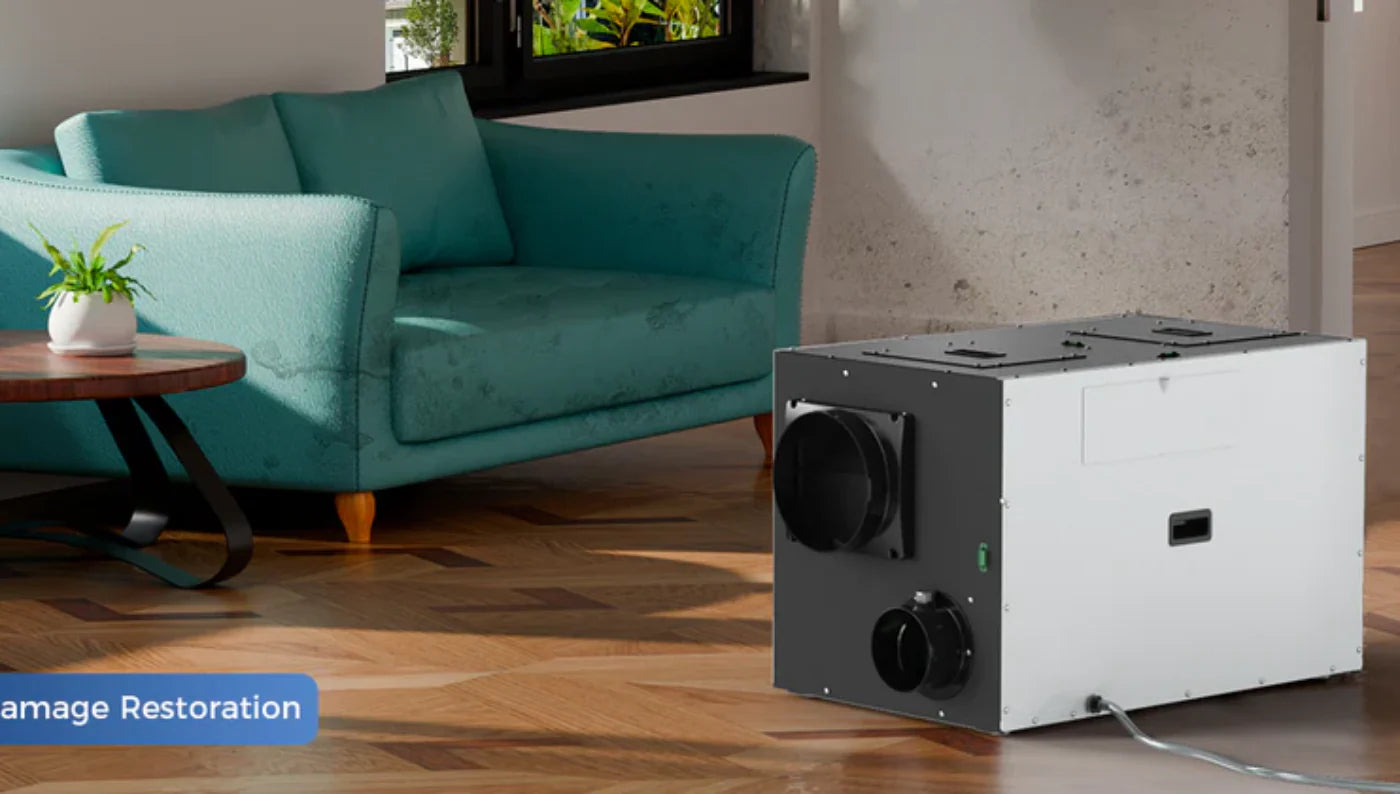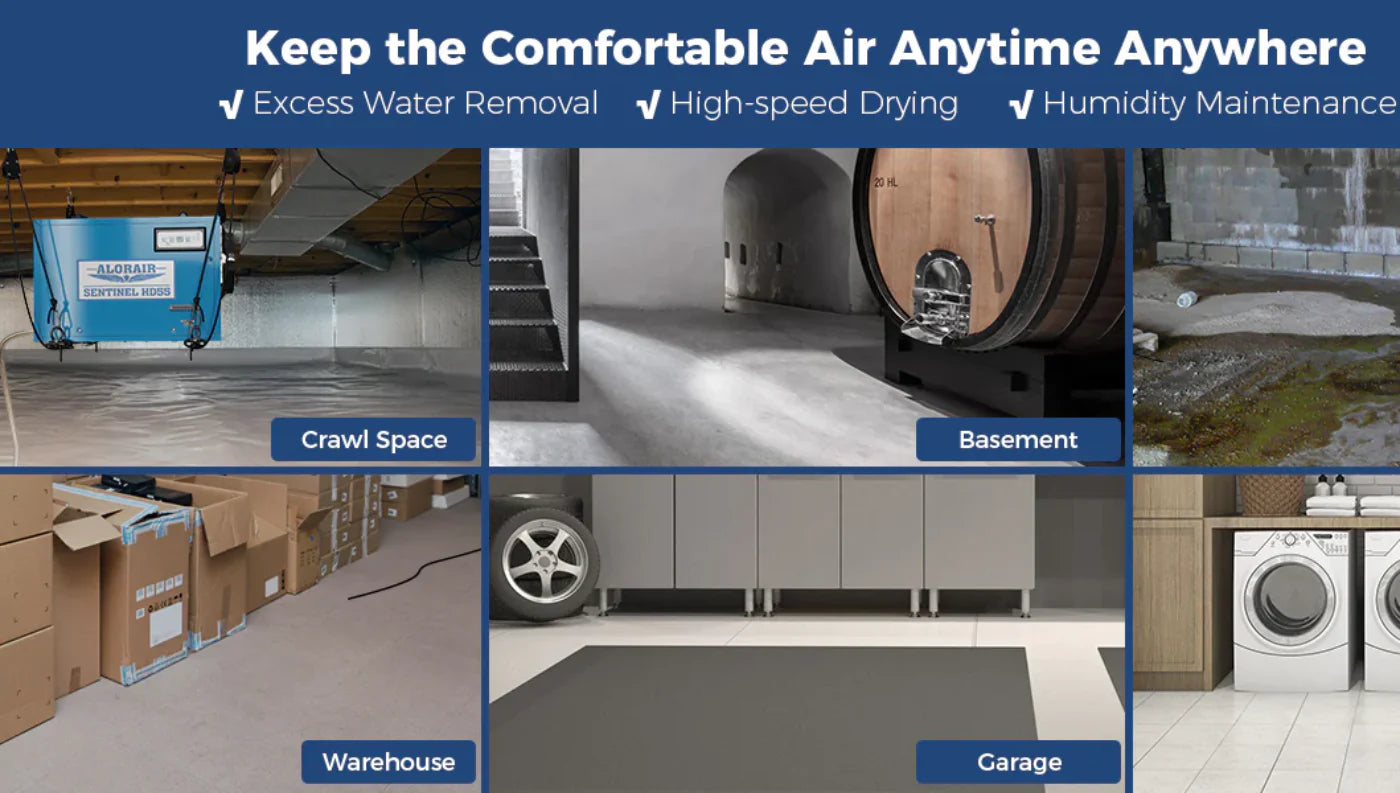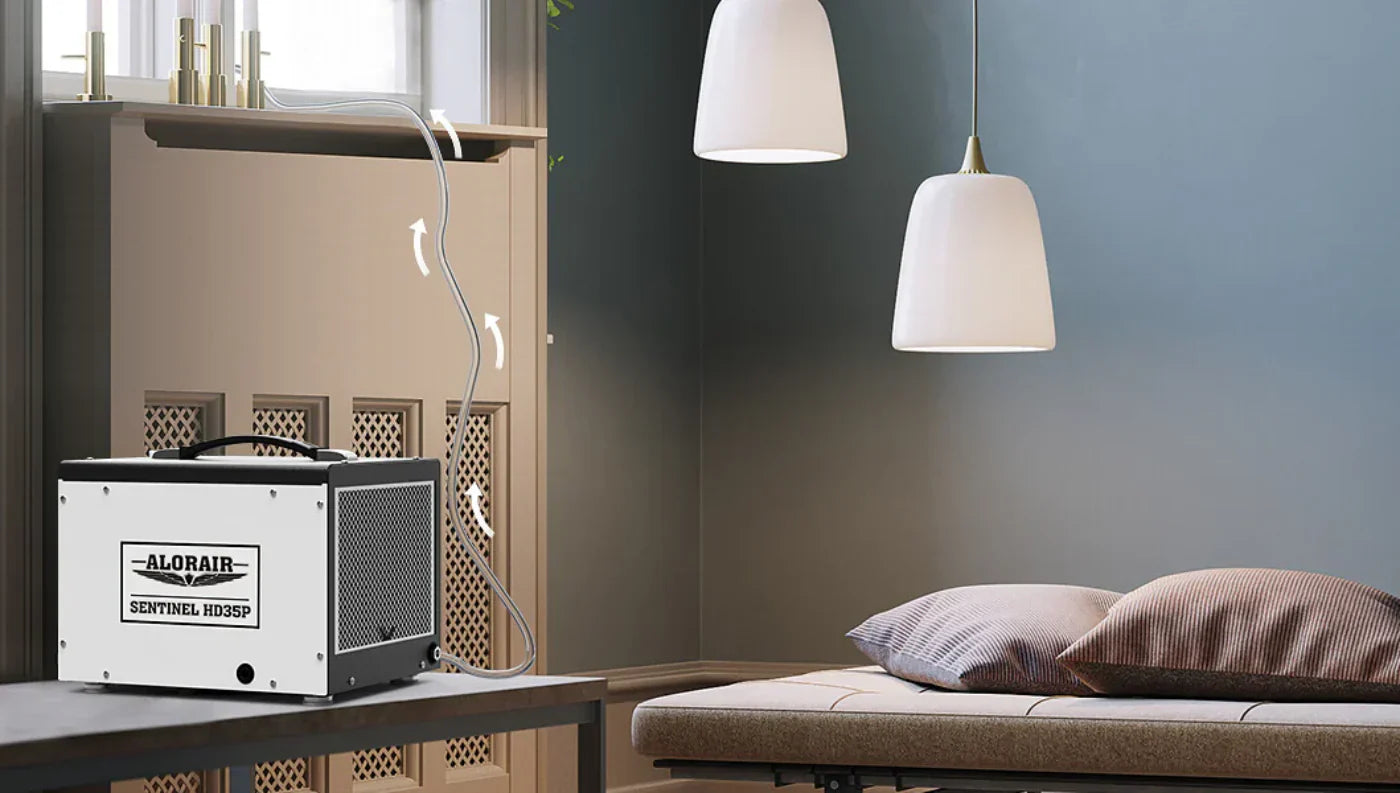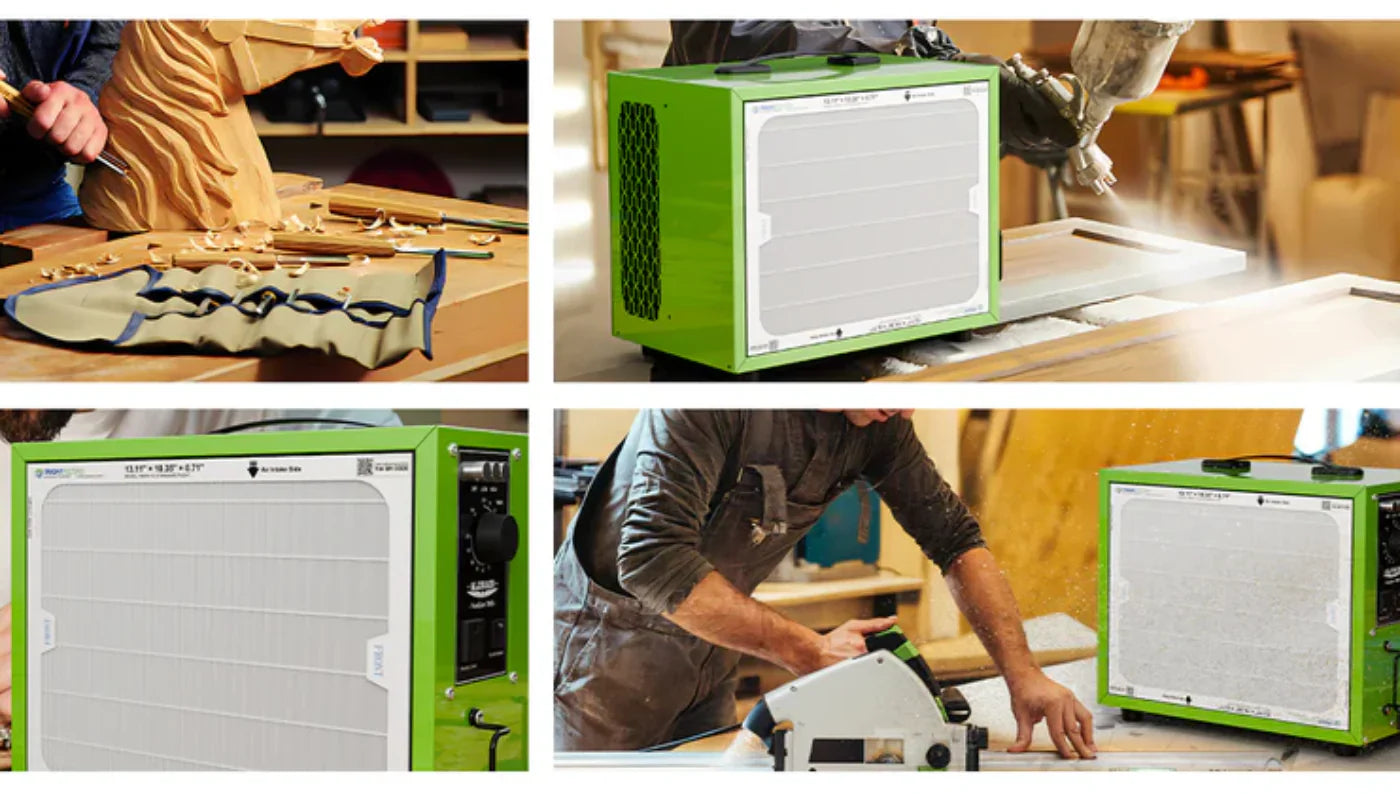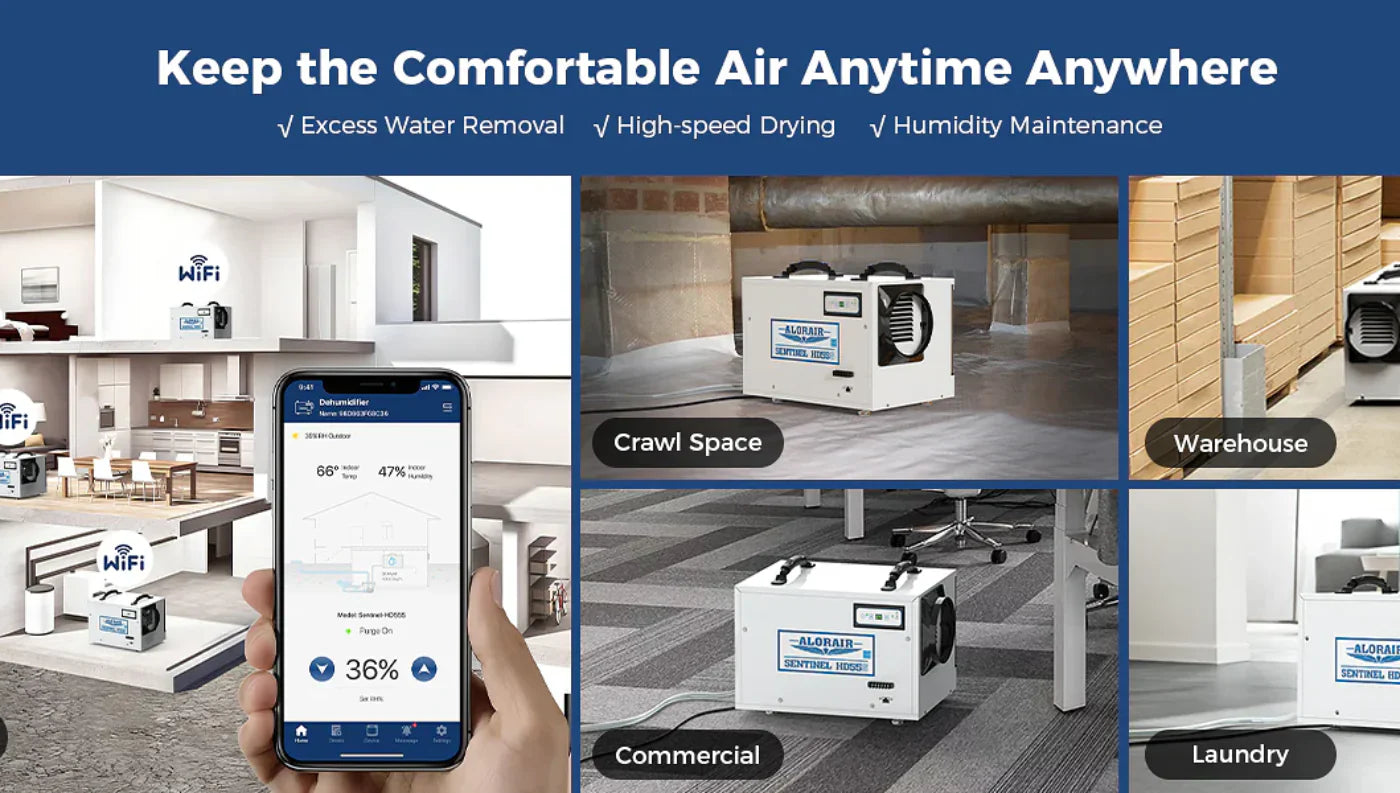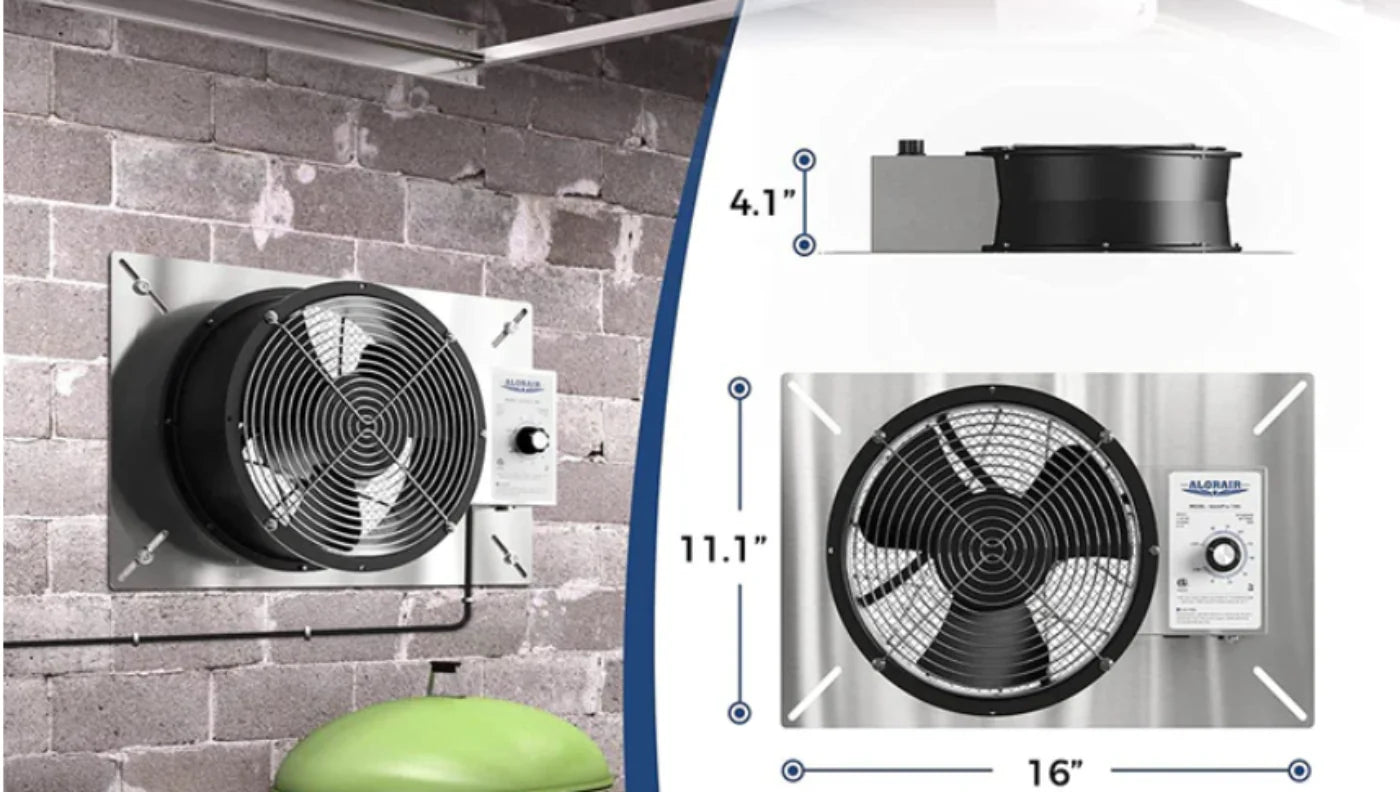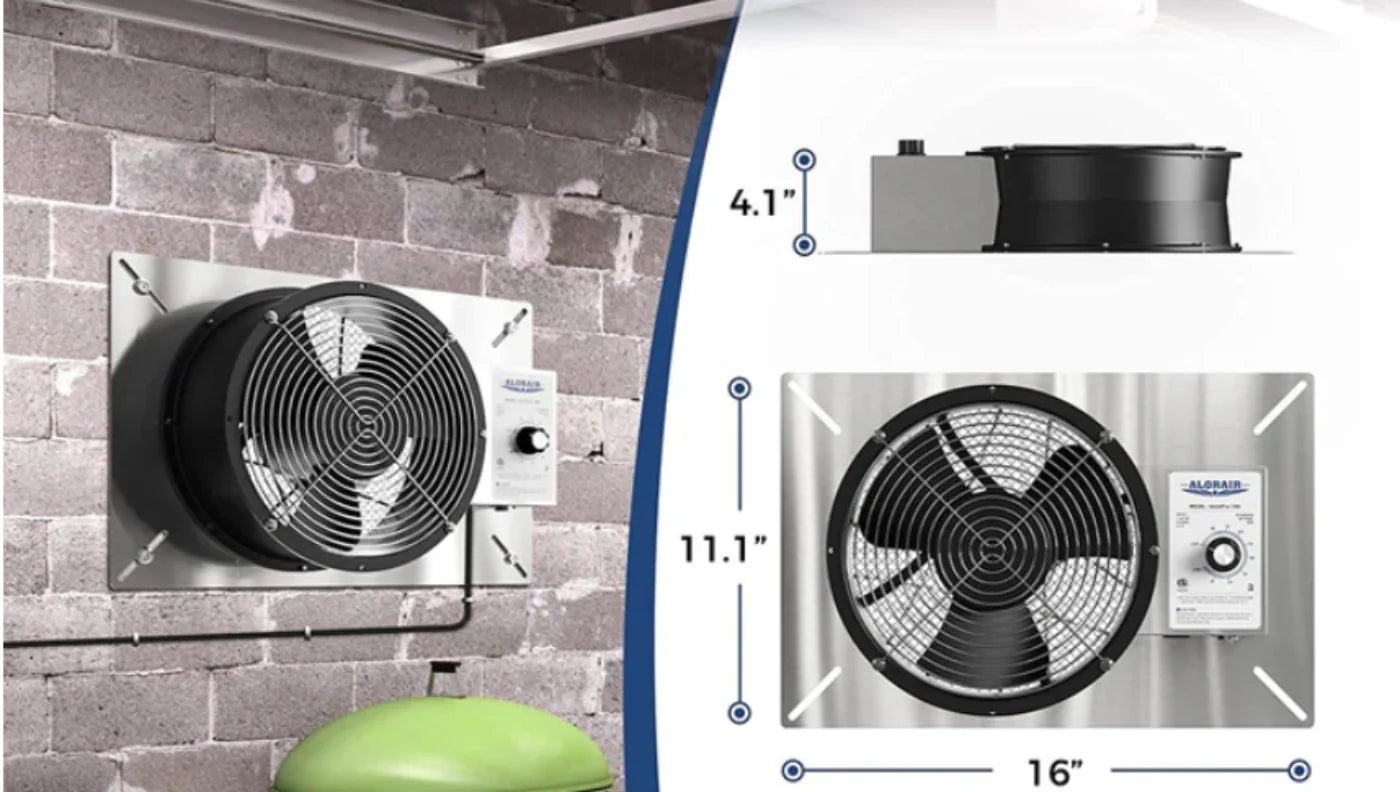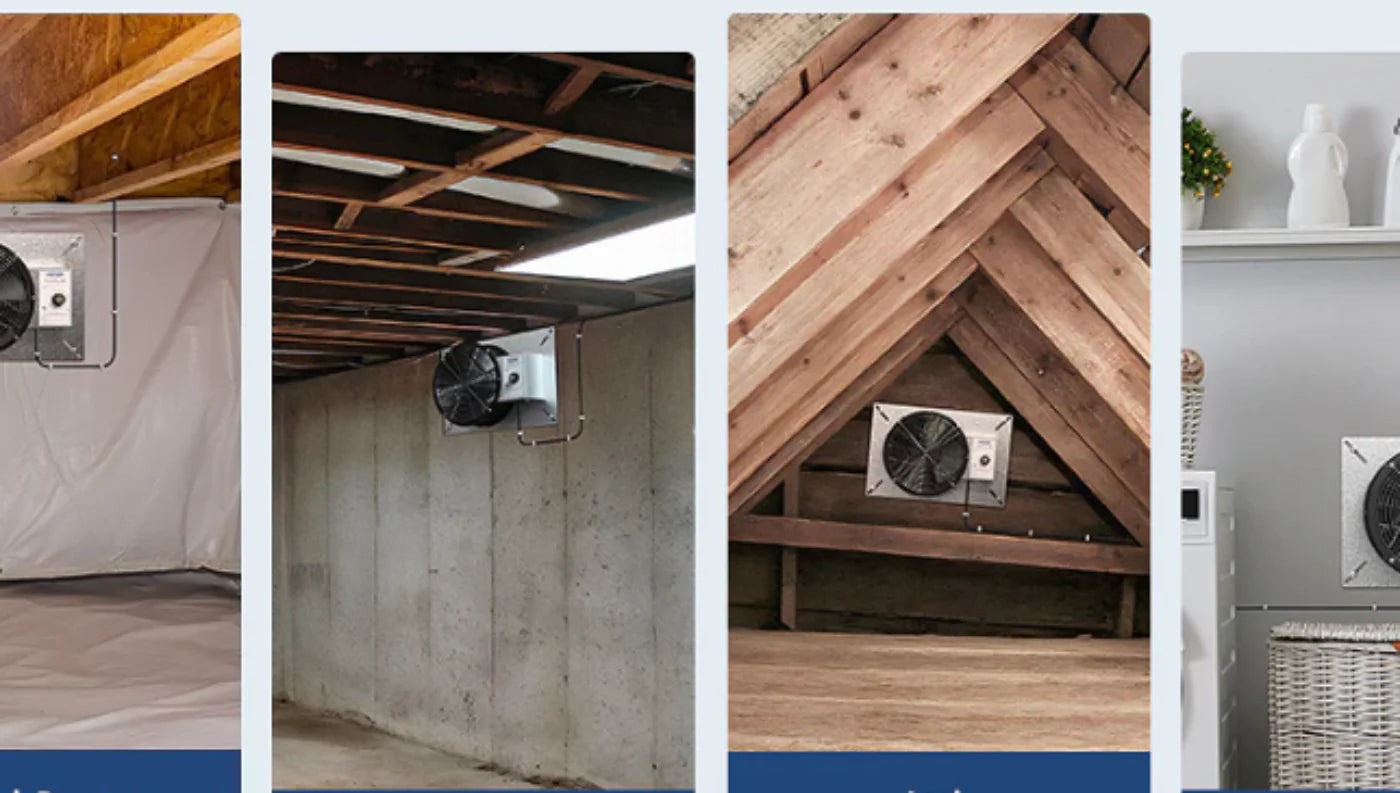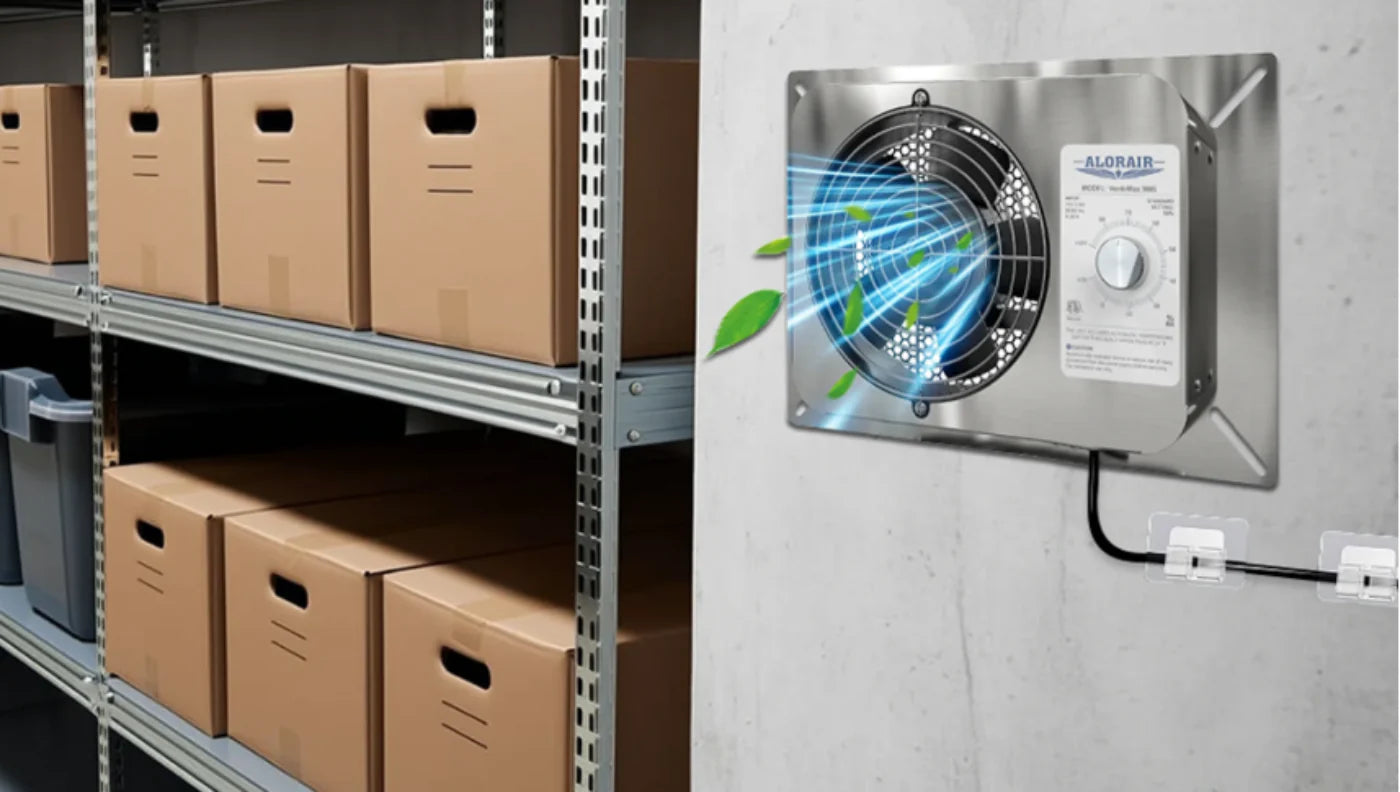Picking the right size dehumidifier for a crawl space doesn’t have to be confusing. This guide keeps it simple. You’ll get a quick answer table, easy steps, and examples (including a crawl space dehumidifier 1000 sq ft case and a crawl space dehumidifier for 2000 square feet case). We’ll also show when to step up a size for best results.
Quick Answer (Use This First)
If your crawl space is sealed/encapsulated and has no standing water, start with this:
|
Crawl space size (approx.) |
Good starting size* |
AlorAir examples |
|
Up to 1,000 sq ft |
“Small” crawl‑space unit |
Sentinel HS35 / HD35P (up to 1,000 sq ft) |
|
1,200–1,300 sq ft |
Small‑to‑mid |
Sentinel HD55 / HD55S (1,200–1,300 sq ft) |
|
1,400–1,600 sq ft |
Mid |
Sentinel HD55P (up to 1,500 sq ft) |
|
1,700–1,900 sq ft |
Mid‑high |
Galaxy 60 (up to ~1,800 sq ft) |
|
2,000–2,300 sq ft |
High |
Galaxy 85P (up to ~2,300 sq ft) |
|
2,400–2,600 sq ft |
High‑capacity |
Sentinel HD90 / HDi90 (up to ~2,600 sq ft) |
|
2,700–3,300 sq ft |
Very high‑capacity |
HDi100 / HDi120 (up to ~2,900–3,300 sq ft) |
*If the space is vented/leaky, very damp, or in a hot‑humid climate, step one size up.
Fast rule: If you’re on the border between two sizes—or your crawl space is unsealed—choose the larger model. It will run fewer hours and keep a steadier 45–55% RH.
Why “PPD” Numbers Can Be Confusing (Keep It Simple)

You’ll see two kinds of capacities:
- PPD @ AHAM (tested ~80°F/60% RH): This is the most useful sizing number.
- PPD @ Saturation (tested at higher temp/humidity): Bigger number, not used for sizing.
Tip: When comparing models, focus on AHAM or the manufacturer’s square‑foot recommendations for crawl spaces. Then apply the step‑up rules below.
Step‑by‑Step: Crawl Space Dehumidifier Sizing

Step 1 — Measure the space
- Square footage: Length × width
- Average height: If the height varies, use an average
- Volume (optional): Sq ft × height (helps you understand air turnover)
Example: 40 ft × 25 ft = 1,000 sq ft; average height 2.5 ft → 2,500 cu ft.
Step 2 — Rate the moisture level
- Normal/Damp: Musty smell at times, no standing water → follow the table.
- Very Damp/Wet: Condensation on surfaces, occasional puddles → step up one size and address drainage first.
- Post‑flood or constant water: Fix bulk water issues before sizing.
Step 3 — Check sealing & vents
- Encapsulated/Sealed (vapor barrier, minimal outside air) → table size is usually fine.
- Vented/Leaky (outside air blowing in, gaps) → step up one size or plan to seal, then size.
Step 4 — Consider climate & layout
- Hot‑humid region (long summers, coastal/Gulf areas) → step up one size.
- Partitioned layout (pockets, piers, blocking airflow) → consider a ductable unit or step up.
Step 5 — Match airflow (CFM) to volume
Bigger spaces need more CFM to move air through the crawl space. As a reference:
- Small units: ~115–130 CFM
- Mid units: ~150–170 CFM
- Larger units: ~200+ CFM
If your crawl space is long, chopped up, or tall, favor higher CFM or a duct‑ready model.
“Two‑Minute Sizing” (Score & Select)
Give your crawl space +1 point each for the following:
- Vented/leaky (not encapsulated) +1
- Very damp/wet signs (condensation, heavy musty odor) +1
- Hot‑humid climate +1
- Partitioned layout (air can’t circulate freely) +1
0–1 points → Use the table size.
2 points → Step up one size.
3–4 points → Step up two sizes or pick a ductable high‑CFM unit.
Examples (So You Can See the Thought Process)

Example A — Crawl space dehumidifier 1000 sq ft
- Size: 1,000 sq ft, 2–3 ft tall, encapsulated
- Moisture level: Damp, no puddles
- Climate: Moderate
- Score: 0 points
- Pick: Sentinel HS35 or HD35P (up to 1,000 sq ft). If you want app control or plan to add ducting later, consider stepping up to the HD55 family.
Example B — Crawl space dehumidifier for 2000 square feet
- Size: 2,000 sq ft, 3 ft tall, not fully sealed, coastal humidity
- Moisture level: Very damp; condensation in summer
- Score: Vented + humid climate = 2 points
- Pick: Step up from “mid‑high” to high‑capacity: HD90/HDi90 (up to ~2,600 sq ft) or Galaxy 85P (to ~2,300 sq ft). If the layout has long runs/partitions, choose a duct‑ready model.
Example C — 1,300 sq ft, mild climate, encapsulated
- Score: 0 points
- Pick: Sentinel HD55 / HD55S (1,200–1,300 sq ft). Add the HD55P if you prefer a built‑in pump.
A Note on Ducting (When It Helps)
If your crawl space has isolated pockets or a long shape, a ductable dehumidifier lets you:
- Pull return air from a distant corner
- Deliver dry supply air evenly along the run
- Reduce “dead zones” and keep humidity uniform
Models like HDi90/HDi100/HDi120 make this easy and maintain good CFM across the space.
Placement Basics (Because Size Isn’t Everything)
- Central location with open air around the intakes/outlet
- On a level riser (protect from dust/water)
- Short, sloped drain to a sump or floor drain (or use a condensate pump)
- No extension cords; use a grounded outlet
- For more, see our install guide on the blog.
Product Cheat Sheet (Match Size to Models)
- Up to 1,000 sq ft → HS35 / HD35P (115 CFM class, compact, optional pump)
- 1,200–1,300 sq ft → HD55 / HD55S / HD55S Wi‑Fi (around 120–130 CFM; compact, popular)
- Up to 1,500 sq ft → HD55P (adds built‑in pump)
- Up to ~1,800 sq ft → Galaxy 60 (ENERGY STAR; ~165 CFM; great efficiency)
- Up to ~2,300 sq ft → Galaxy 85P (higher capacity; built‑in pump)
- Up to ~2,600 sq ft → HD90 / HDi90 (duct‑ready option; ~210 CFM)
- Up to ~2,900–3,300 sq ft → HDi100 / HDi120 (very high capacity; duct‑ready)
Tip: If you’re comparing two options, choose the quieter, more efficient unit with the drain style you prefer (gravity or built‑in pump) and the controls you’ll actually use (on‑unit, remote, or app).
Troubleshooting Sizing (If RH Won’t Hold)
-
Stuck above 55% RH?
- Check air leaks (vents, rim joist gaps).
- Verify drain slope (backup can auto‑shut a unit).
- Clean/replace filters.
- Confirm set point (start at ~50% RH).
- If everything’s right and the unit runs constantly, you may be undersized—step up.
-
Short cycling (on/off often)
- Airflow may be blocked; increase clearance.
- The set point may be too aggressive for the conditions; relax to 50–55% RH.
- In partitioned spaces, consider ducting.
Frequently Asked Questions
How to size a dehumidifier for a crawl space?
Measure square footage, assess moisture level, and note sealing/climate. Start with the Quick Answer table and step up one size if the space is vented, very damp, or in a hot‑humid region. If layout is complex, pick a duct‑ready model.
How do I calculate what size dehumidifier I need?
Use this two‑minute score: +1 for vented/leaky, +1 for very damp, +1 for hot‑humid climate, +1 for partitioned.
- 0–1 points → go with the table size.
- 2 points → step up one size.
- 3–4 points → step up two sizes or duct for even coverage.
What size dehumidifier do I need for a 2000 sq ft basement (or crawl space)?
For 2,000 sq ft, start at mid‑high to high‑capacity. In average conditions, look at Galaxy 85P or HD90/HDi90; step up if the area is unsealed or very humid. If it’s a basement with open layout and mild climate, the same guidance applies.
Is it better to oversize or undersize a dehumidifier?
If you must choose, slightly oversize. A bigger unit runs fewer hours to hit ~50% RH. Undersizing forces long runtimes, struggles in summer peaks, and may never reach set point.
Why Choose AlorAir
- Built for crawl spaces: rugged metal housings, compact footprints
- ETL safety certified; select models ENERGY STAR®
- Smart controls: on‑unit, remote, or AlorAir‑C app (Wi‑Fi)
- 5‑Year limited warranty and U.S. support
Conclusion
Crawl space dehumidifier sizing comes down to three things: space size, moisture load, and airflow. Start with the table, apply the step‑up rules for venting/climate/wetness, and pick a model with the CFM and features you want. When in doubt—and especially for ~2,000 sq ft and up—choose a little more capacity or a duct‑ready unit to keep humidity steady all year.
Need a quick recommendation? Tell us your sq ft, climate, and whether the space is sealed. We’ll point you to the best fit within minutes.




